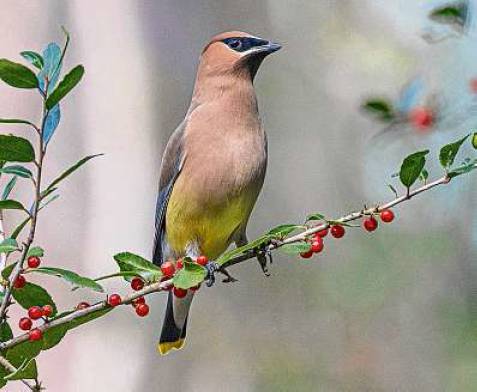NATURE
Cedar waxwings flock to Houston for the new year
By Gary Clark CORRESPONDENT
Flocks of cedar waxwings are gathering in our yard like partygoers festooned in color as if ready to celebrate the new year.
The bird sports a crest that swoops over the head and has a natty black mask over its eyes. A walnut-brown hue topside contrasts with a pale yellow belly grading to white beneath the yellow-tipped tail.
The waxwing gets its name from waxy-looking red tips on the secondary wings; it earned its cedar distinction from a diet of cedar berries, more precisely called juniper berries.
As consummate eaters of sugary fruits, the birds in our yard crowd into a large yaupon bush to devour the red berries. They flit frenetically among the branches, reveling with high-pitched twittering tunes — “screee-screee-screee.”
If freezing weather causes some of the yaupon berries to ferment and produce ethanol, the birds could get a little tipsy before the new year. During past winter freezes, Houston-area birdwatchers have seen waxwings staggering along the ground by the yaupons.
Unfortunately, many drunken waxwings perish. When on the ground, they cannot escape predators like cats or hawks. When they try to fly, they crash to their deaths against windowpanes or get killed on roadways by oncoming cars. They could also die of alcohol poisoning.
Yet waxwings are endowed with exceptionally large livers that may help them ward off intoxication, assuming they don’t engorge themselves on the fermented berries.
Hopefully, on New Years Eve, they instead will be roosting so they can wake up on the first day of 2023 twittering in a yaupon bush or other fruit-bearing vegetation. The birds will readily devour fruits from deciduous holly, hawthorn, pyracantha, wax myrtle, honeysuckle and cedar.
Of course, the joy of seeing flocks of cedar waxwings is offset by the aggravation of their messy globs of poop on the car or driveway. Abundant poop is the result of a specialized digestive tract that rapidly absorbs nutrients from sugar-rich fruits while excreting waste, including seeds.
That’s great for propagating plant seeds but unsightly when splattered on a driveway.
Cedar waxwings are wayfarers, constantly on the move in search of berries. Flocks wander south from northern U.S. and Canadian breeding grounds in autumn to random winter locations. They head back to breeding grounds in the spring, although not necessarily to the same area.
Email Gary Clark, author of “Book of Texas Birds” with photography by Kathy Adams Clark (Texas A&M University Press), at Texasbirder@comcast.net.

